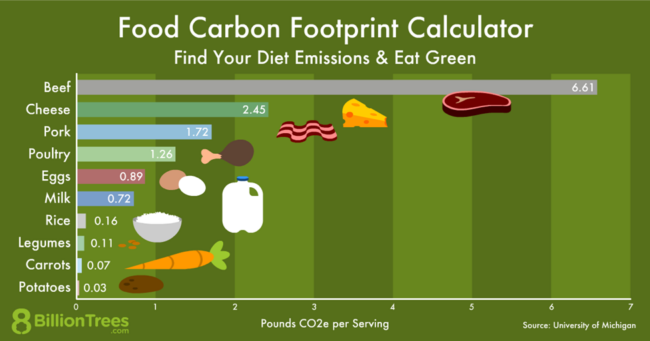Planet Friendly
How does PCC identify its Planet Friendly Foods?
We’re proud to announce our Planet Friendly Menu. Using our menu ingredients list we can measure a dish’s carbon footprint. For each ingredient we calculate the carbon emissions by analyzing the agricultural supply chain and land used to produce that ingredient. We total all the ingredients in a specific meal to produce the total carbon output.
How does your scale work?
The calculator works using well established international agricultural and supply chain data sets that account for the CO2e created at the feed, farm, processing, transport, and packaging stages. Our calculator also accounts for loss of product that can occur at each of the stages in the supply chain. Additionally, our calculator allows us to quantify the carbon opportunity cost associated with the cropland and pastureland needed to produce a particular food. After calculating all the information, we can produce a clear and accurate carbon profile for our menu items. Currently our most planet friendly items are on the menu and in the future, we will then further break down the carbon profile of our entire menu into a convenient and easy 1-5 rating where 1 is the best possible score and 5 would be over the **“allowable” carbon emission range.
Agricultural supply chain emissions.
The majority of these GHG emissions are related directly to the purchased foods and occur on farms to produce both food and animal feed (Poore and Nemecek 2018). They include livestock-related emissions (enteric fermentation, manure management, livestock wastes on pastures) as well as emissions from soil fertilization, energy use, and rice paddies.
The minority of these emissions occur at supply chain stages between the farm gate and the point of purchase, including transport, packaging, and processing (Poore and Nemecek 2018). It’s also important for us to account for the emissions associated with food losses that occur at each supply chain step.
Carbon opportunity costs.
Life-cycle assessments of food production commonly either do not account for emissions from land-use change, or only account for recent (e.g., past 20 years) land-use change. However, all agricultural land use has an opportunity cost. Carbon opportunity costs estimate the “missed potential carbon sink” if the land used to produce the food sourced by the food provider were instead able to return to its native vegetation (e.g., forests) (Schmidinger and Stehfest 2012; Hayek et al. 2020). Conversely, this metric is also an estimate of the likely potential additional carbon losses to clear natural ecosystems to produce another unit of a food. Shifting consumption toward plant-based foods, which have lower carbon opportunity costs, can help prevent future deforestation (Hawken 2017). Because carbon losses from converting native ecosystems to agriculture occur quickly, but food production often continues on a cleared plot of land for many years, the calculation annualizes carbon opportunity cost values over a 33-year period (Searchinger et al. 2018).
Given this data, and in accordance with the Paris agreement projected out to 2030, much greater emissions reduction efforts will be required in order to hold the increase in global average temperatures to 1.5° C above pre industrial levels. This tool empowers us and makes it abundantly clear that we have a great opportunity each and every meal to effect the change we all want and need.
What impact does my food choice have on the climate?
As we all know the increasing global greenhouse gas (GHG) emissions have reached levels that are now changing the climate. While fossil fuels use is a leading cause, 25% of the GHG emissions come from food production of which 67% of that comes from animals. Our food choices can greatly impact GHG emissions and make a difference. Individual meal choices add up and we are dedicated to bringing the tools, awareness, and options to make the best decisions for your personal health and the health of our planet
What food types are more Planet Friendly?
In general, plant-based foods are less resource-intensive to produce than animal proteins. Nutrient-dense diets that are high in fiber, fruits, and vegetables and low in sodium, saturated fat, and sugar have been linked to reduced chronic disease risk and improved health outcomes, suggesting ample opportunities for serving meals that are both good for climate and human health. Moving away from a more meat-centered diet benefits the climate, the environment, and your health. In addition, farmland used to raise animals for meat, over time, leaves the soil with high levels of nitrogen due to animal waste. Livestock accounts for up to half of the technical mitigation potential of the agriculture, forestry, and land-use sectors, through management options that sustainably intensify livestock production, promote carbon sequestration in rangelands and reduce emissions from manures, and ultimately through reductions in the demand for livestock products.

** ”allowable” carbon per meal is based off a reduction of 38% carbon emissions from our current levels per meal in order to maintain a 1.5° C increase in temperature from pre industrial levels. – Paris Accord
